Rules of water supply and sanitation: calculation of balance + norms of water supply and consumption
Arrangement of communications during the construction or modernization of a house is a rather complex and responsible process.
Already at the design stage of these two important engineering systems, it is necessary to know and strictly follow the rules of water supply and sanitation in order to avoid future operational problems and conflicts with environmental services.
In our material we will try to understand these rules, which are difficult at first glance, and will tell our readers why a water meter is needed and how to correctly calculate the volume of water consumption.
The content of the article:
- Scope of influence of the regulatory document
- Rules for compiling a water balance
- Requirements for installing water meters
- Examples of calculating water consumption and wastewater disposal
- Rationing is the basic rule of any calculations
- Relationship between water consumers and service provider
- Conclusions and useful video on the topic
Scope of influence of the regulatory document
«Rules for cold water supply and sanitation" - this is the full name of the document approved on July 29, 2013 under N 644. The latest edition is April 2018, changes and additions are valid from April 12, 2018.
The rules define the relationship between subscribers (consumers of services) and organizations that supply them, based on the conclusion of binding contracts.
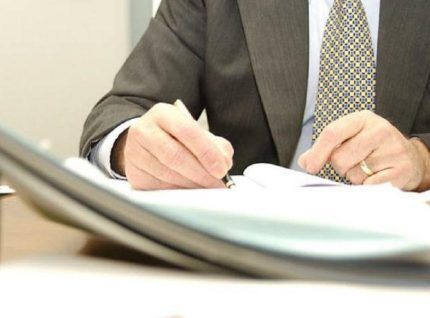
The document also discusses:
- consumers of services - individuals, budget organizations, enterprises, etc.;
- algorithm for connecting objects to central systems (central systems);
- accounting of released water, accounting of diverted wastewater, quality control;
- consumers who are required to take into account the discharge of wastewater into the central heating system using measuring instruments;
- calculation of compensation for the discharge of excessively polluted wastewater, the procedure for informing about changes in their composition and properties (submission of declarations);
- standards, a mechanism for monitoring their use in practice, determining the amount of excess payment;
It must be thought out and provided, and if necessary, access to the subscriber’s water supply and sewerage communications, to the points of water and wastewater sampling must be created.
Rules for compiling a water balance
Calculation of the ratio of water consumption and wastewater volumes is carried out for each object individually with an assessment of its specifics.
The purpose of the building or premises, the number of future users, and the minimum (maximum) expected water consumption for domestic or industrial needs are taken into account. All water is taken into account - drinking water, technical water, its reuse, waste water, storm discharge into sewers.
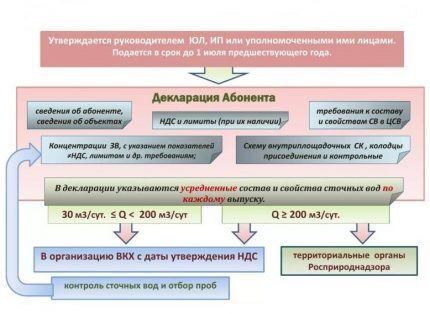
Goals and objectives solved by drawing up a balance sheet:
- Obtaining permission for water consumption and wastewater disposal when connecting to a centralized system;
- Selection of water and sewer pipes of optimal diameter;
- Calculation of other parameters - for example, power submersible pump, if we are talking about using a well in a private household;
- Obtaining a license for the right to use natural resources (relevant again for the example described above - your own independent source of water);
- Concluding second-order contracts - let’s say you rent space in an office center, the owner of the building is the subscriber of the city water utility, and all tenants receive water from his (the owner’s) water supply and discharge wastewater into his sewer system. Therefore, the owner of the building must pay.
The water balance is a table that shows the ratio of water used and waste water discharged for the year.
There is no single form of such a table approved at the federal level, but the initiative is not prohibited, and water utilities offer their own filling out samples for customers.

In general terms, drawing up a water balance for a small enterprise will look like this:
- Step 1. We enter consumer groups with numbering, name and quantitative characteristics in the first three columns.
- Step 2. We are looking for standards for each group for water consumption, using internal technical regulations (for the operation of bathrooms and showers), certificates (from the personnel department about the number of personnel, from the canteen about the number of dishes, from the laundry about the volume of laundry), SNiP 2.04.01-85 - “ Internal water supply and sewerage of buildings."
- Step 3. We calculate the total water consumption (cubic meters/day), determine the sources of water supply.
- Step 4. We enter data on water disposal, noting separately irrecoverable losses (watering lawns, water in the pool, etc. that does not go into the sewer system).
As a result, the reasonable difference between water disposal and water consumption can be 10-20%. Values up to 5% are usually neglected, and it is considered that the discharge into the sewer is 100%.
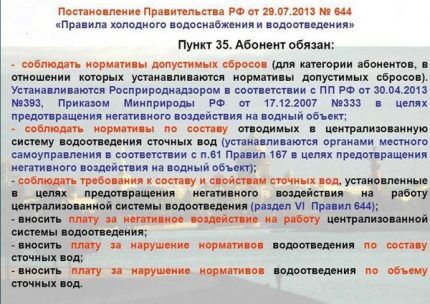
Requirements for installing water meters
An accurately calculated water balance is a significant argument in the justification water usage fees. With it, you can try to challenge the supplier’s inflated average tariffs, which include the cost of water losses as a result of pipeline accidents, repair work, leaks in basements, prove the need to take into account the seasonality factor, etc.
Practice shows, however, that the truth is not easy to achieve, and the best way out is installation of a water supply meter. According to his readings, the amount of water used is determined down to the drop.
If you have a meter, paying for water is simplified: indicator taken from the scoreboard multiplied by the price of 1 cubic meter of water. So, counters are installed for both cold and hot water pipes. It is important to monitor the safety of the seals and periodically (once every few years) check their serviceability.
For sewer systems, waste water meters are not provided (with the exception of specific industrial enterprises). Their volume is equal to the volume of water consumed.
Common house and individual water meters help save housing and utility costs. The amount of money in the receipt directly depends on the number of cubic meters saved. The massive introduction of water meters into life also disciplines the employees of water utilities. It is no longer possible to uncontrollably attribute losses from water losses due to worn-out water supply and sewerage networks to the consumer.
The water supply rules are supplemented with provisions regarding the installation of meters and their commissioning. You can install the device yourself and invite a specialist to your home to sealing.
There are two requirements for installing a water meter:
- Place a coarse filter in front of the device to protect against small debris found in tap water.
- Use a check valve at the outlet of the meter to prevent it from spinning in the opposite direction.
Before purchasing a meter, you must check its passport data and compare it with the numbers on the body and parts of the device. You should also inquire about verifications carried out and make sure you have the installation kit.
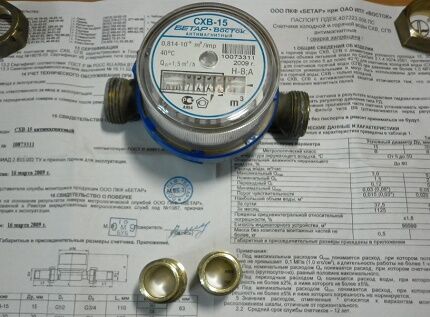
Examples of calculating water consumption and wastewater disposal
The load on pipelines and devices that ensure an uninterrupted supply of water to various sanitary equipment (kitchen sink, bathroom faucet, toilet, etc.) depends on its flow rates.
When calculating water consumption, the maximum water consumption per day, hour and second is determined (both total and cold and hot separately). There is a calculation method for water drainage.
Based on the results obtained, the parameters of the water supply system are established according to SNiP 2.04.01-85 - “Internal water supply and sewerage of buildings"[1] and some additional ones (counter passage diameter, etc.).
Example 1: calculating volume using formulas
Initial data:
A private cottage with a gas water heater, 4 people live in it. Plumbing equipment:
- faucet in the bathroom – 1;
- toilet with flushable cistern in the bathroom – 1;
- faucet in the kitchen sink - 1.
It is necessary to calculate the water flow and select the cross-section of the supply pipes in the bathroom, toilet, kitchen, as well as the minimum diameter of the inlet pipe - the one that connects the house to a centralized system or source of water supply. Other parameters from the mentioned building codes and rules are not relevant for a private house.
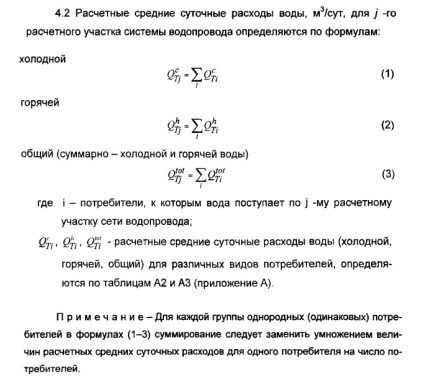
Calculation:
1. Water consumption (max) in 1 sec. calculated by the formula:
Qsec = 5×q×k (l/sec), Where:
q – water consumption per 1 second. for one device according to paragraph 3.2 [1]. For the bathroom, toilet and kitchen - 0.25 l/sec, 0.1 l/sec, 0.12 l/sec, respectively (Appendix 2 [1]).
k – coefficient from Appendix 4 [1]. Determined by the probability of plumbing action (R) and their number (n).
2. Let's define R:
P = (m×q1)/(q×n×3600), Where
m - People, m = 4 people;
q1 – the total maximum rate of water consumption for the hour of greatest consumption, q1 = 10.5 l/hour (Appendix 3 [1], presence of water supply, bathroom, gas water heater, sewerage system in the house);
q – water consumption for one device per 1 second;
n – number of plumbing units, n = 3.
Note: Because the value q different, then we replace q*n summing the corresponding numbers.
P = (4×10.5)/((0.25+0.1+0.12)×3600) = 0.0248
3. Knowing P And n, let's define k according to table 2 of appendix 4 [1]:
k = 0.226 – bathroom, toilet, kitchen (based on n × P, i.e. 1 × 0.0248 = 0.0248)
k = 0.310 – cottage as a whole (based on n × P, i.e. 3 × 0.0248 = 0.0744)
4. Let's define Qsec:
bathroom Qsec = 5×0.25×0.226 = 0.283 l/sec
bathroom Qsec = 5×0.1×0.226 = 0.113 l/sec
kitchen Qsec = 5×0.12×0.226 = 0.136 l/sec
cottage as a whole Qsec = 5×(0.25+0.1+0.12)×0.310 = 0.535 l/sec
So, the water flow is obtained. Let us now calculate the cross-section (internal diameter) of the pipes using the formula:
D = √((4×Qsec)/(PI×V)) (m), Where:
V – water flow speed, m/sec. V = 2.5 m/s according to paragraph 7.6 [1];
Qsec – water consumption per 1 second, m3/sec.
bathroom D = √((4×0.283/1000)/(3.14×2.5)) = 0.012 m or 12 mm
bathroom D = √((4×0.113/1000)/(3.14×2.5)) = 0.0076 m or 7.6 mm
kitchen D = √((4×0.136/1000)/(3.14×2.5)) = 0.0083 m or 8.3 mm
cottage as a whole D = √((4×0.535/1000)/(3.14×2.5)) = 0.0165 m or 16.5 mm
Thus, a pipe with an internal cross-section of at least 12 mm is required for a bathroom, 7.6 mm for a bathroom, and 8.3 mm for a kitchen sink. Minimum diameter of the inlet pipe to supply 3 plumbing fixtures – 16.5 mm.
Example 2: simplified definition
Those who are intimidated by the abundance of formulas can make a simpler calculation.
It is believed that the average person consumes 200-250 liters of water per day.Then daily consumption for a family of 4 people will be 800-1000 liters, and monthly consumption will be 24,000-30,000 liters (24-30 cubic meters). In private houses in the courtyards there are swimming pools, outdoor showers, drip irrigation systems, i.e. part of the water consumption is irrevocably carried out onto the street.
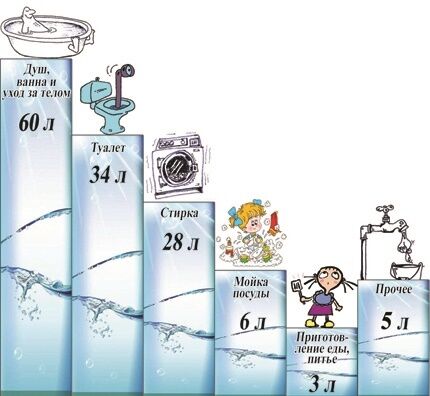
Water consumption is increasing, but there is still a suspicion that the approximate standard of 200-250 liters is unreasonably high. And indeed, after installing water meters, the same family, without changing their everyday habits, adds 12-15 cubic meters to the meter. m, and in economy mode it turns out even less - 8-10 cubic meters. m.
The principle of drainage in a city apartment is this: as much water as we consume, we pour into the sewer. Consequently, without a meter they will count up to 30 cubic meters. m, and with a meter - no more than 15 cubic meters. m. Since in the private sector not all consumed water goes back to the sewer system, it would be fair to use a reduction factor when calculating water disposal: 12-15 cubic meters × 0.9 = 10.8-13.5 cubic meters. m.
Both examples are conditional, but a table with a real calculation of water consumption and disposal, which can only be done by a qualified engineer, should be available to all economic entities (enterprises, housing stock) that collect water for drinking, sanitary and hygienic, industrial needs and discharge drains.
Responsibility for the reliability of the data used in the calculation rests with the water user.
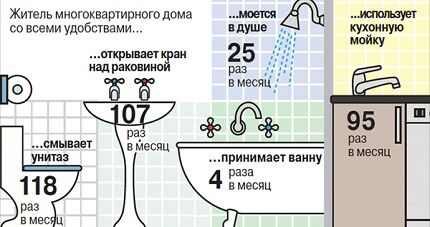
Rationing is the basic rule of any calculations
Each region has its own standards for water consumption (drinking, for sanitary and hygienic needs, for everyday life and household use). This is explained by different geographical locations and weather factors.
Let’s take the daily norms of volumetric parameters of water consumption and wastewater disposal, distributed for household and household needs. Let's not forget that they are the same in terms of water supply and disposal, but depend on how comfortable the home is.
Standard water consumption values:
- with outdoor standpipe – from 40 to 100 liters per person;
- apartment-type residential building without baths – 80/110;
- same with baths and gas heaters – 150/200;
- with centralized cold and hot water supply – 200-250.
There are also water consumption standards for caring for pets and poultry. They include costs for cleaning pens, cages and feeders, feeding, etc. 70-100 liters are provided for a cow, 60-70 liters for a horse, 25 liters for a pig, and only 1-2 liters for a chicken, turkey or goose.
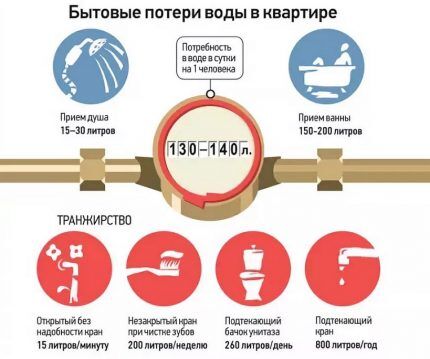
There are standards for the operation of vehicles: tractor equipment - 200-250 liters of water per day, car - 300-450. It is necessary to plan water consumption for fire extinguishing for all buildings and structures, regardless of operational purpose.
Even for gardening societies there is no exception: the water consumption rate for extinguishing a fire outside is 5 liters per second for 3 hours, for an internal fire - from 2 to 2.5.
Water for fire extinguishing is taken from the water supply.Fire hydrants are placed on water pipes in wells. If this is not technically feasible or unprofitable, then you will have to take care of a reservoir with a supply of water. This water must not be used for other purposes; the period for restoring the supply in the reservoir is three days.
Irrigation water consumption per day: 5-12 l/m2 for trees, shrubs and other plantings in open ground, 10-15 l/m2 – in greenhouses and greenhouses, 5-6 l/m2 – for lawn grass and flower beds. In industry, each sector has its own characteristics of rationing water consumption and waste disposal - water-intensive are pulp and paper production, metallurgy, petrochemistry, food industry.
The main purpose of rationing is to economically justify the norms of water consumption and drainage for the purpose of rational use of water resources.
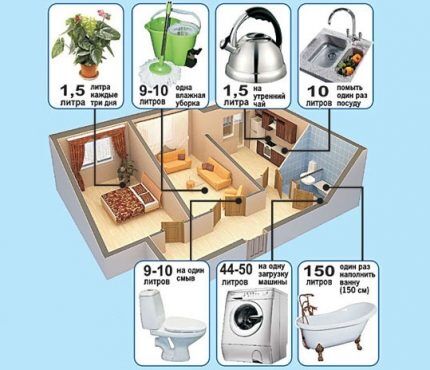
Relationship between water consumers and service provider
By entering into a contractual relationship with a water supply and sewerage organization, you become a consumer of water supply/sewage services.
Your rights as a user of the service provided:
- demand from the supplier the continuous provision of appropriate services (standard water pressure, its chemical composition safe for life and health);
- apply for the installation of water meters;
- demand recalculation and payment of penalties if the service is not provided in full (the act must be drawn up within 24 hours after submitting the application);
- terminate the contract unilaterally, but subject to 15 days notice and full payment for the services received;
The subscriber has the right to receive payment information (personal account status) free of charge.
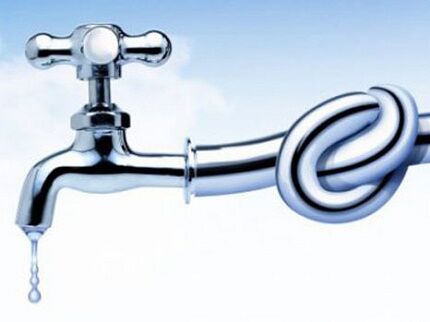
List of rights of the second party:
- stop (with a few days' prior notice) the supply of water and the collection of wastewater, in whole or in part, if the technical condition of the water supply networks and sewerage systems is unsatisfactory;
- require access to the client’s territory to take readings of water meters, check seals, and inspect water supply and sewer systems;
- carry out preventative maintenance according to schedule;
- turn off water to debtors;
- stop water supply without warning in case of accidents, natural disasters, power outages.
Disputes and disagreements are resolved through negotiations or in court.
Conclusions and useful video on the topic
How to correctly calculate water consumption:
Water saver. Water consumption is reduced by 70:
In order to fully understand the intricacies of water supply and wastewater disposal from the point of view of the rules, you need to be a specialist with a specialized education. But everyone needs general information to understand how much water we get and how much we pay for it.
Economical water consumption and bringing specific consumption to the level of true needs are not mutually exclusive concepts, and this is worth striving for.
If, after studying the material, you have questions about calculations or water consumption standards, please ask them in the comments. Our specialists are always ready to clarify unclear points.




Installing a meter is certainly more profitable than calculating water supply and sewerage according to standards. The trick is that the volume of sewerage is in fact always greater than the water supply (we have meters at work for sewerage, we pay two different organizations for supply and disposal, and household waste flushed down the toilet and waste products are also disposed of) , but you pay, it turns out, for the same volume. But here, probably, the tariff includes an additional CT for the population.
We installed water meters in the apartment - and immediately began paying much less. And we are absolutely sure that this is only our consumption, and not the addition of the water utility. The meters, of course, were installed by a plumber from the water supplier. This is also a good discipline in terms of saving - you always see how much water you spent. I constantly monitor my consumption so that I stay within the norms and don’t overpay.
The water consumption rate, no matter how you count it, is set by the monopolist Vodokanal. The price per cubic meter of water is set by the scientific method of analogues (“the average of neighboring hospitals”). That is, by analogy with neighboring Vodokanals. So it turns out that a cube of cold water supplied by a pump costs the same as a cube of gravity sewerage, and hot forty-degree water costs the same as sixty-degree water.
I have a counter. According to the project, I was provided with 2 cubic meters per day. Actual consumption is no more than 5 cubic meters per day. Vodokanal refuses to renew the contract until I purchase additional capacity. The cost is 93,000 rubles per 1 cubic meter. I’m ready to buy 3 more cubic meters, but... based on the balance of water consumption and wastewater disposal, they calculated 12 cubic meters per day. But I’m not ready to buy 10 more cubes. Not even able to.
Good afternoon, in a 5-storey apartment building with 5 entrances for 80 apartments, the developer installed 100 mm polypropylene instead of the design 50 mm, with 32 mm wiring across the floors. Could this be the reason that on 5 floors the pressure is either bad or there is no water at all. At times in the early morning the pressure is good, even very good. Moreover, about 50-60% of the residents moved in.
Thank you.
Good afternoon, in a private house there is an IPU installed for cold water, the tap of which is placed outside for watering the garden. Is it legal to charge a tariff for both water supply and sewerage when calculating?
Private residential building for two owners. The owners have no mutual claims regarding cold water supply. The house is powered by a pipe with a diameter of 1/2″. There is only one personal account for one of the owners. A water meter has been installed according to the rules. QUESTION: What is the maximum volume of water / m3 / per house per month? P. S - sewerage - central.